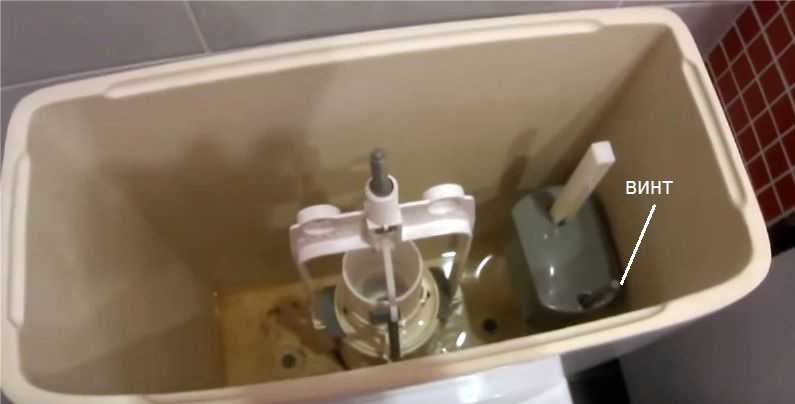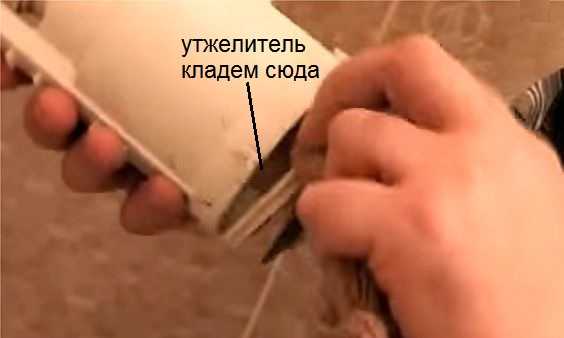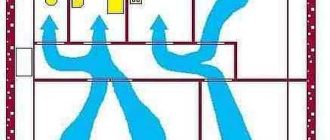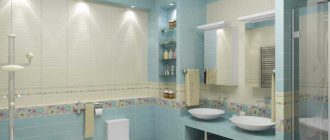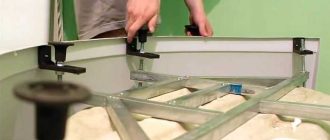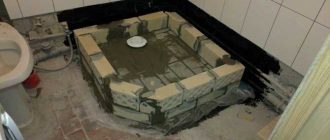No matter how high quality the toilet bowl and fittings are, there are periodic problems: the water is not drawn, or on the contrary, constantly leaks from the drain. All these malfunctions are associated with the fittings (drain and inlet valves), which are put in the cistern. Next and we will talk about how to install it independently, with your own hands, change, adjust and repair it.
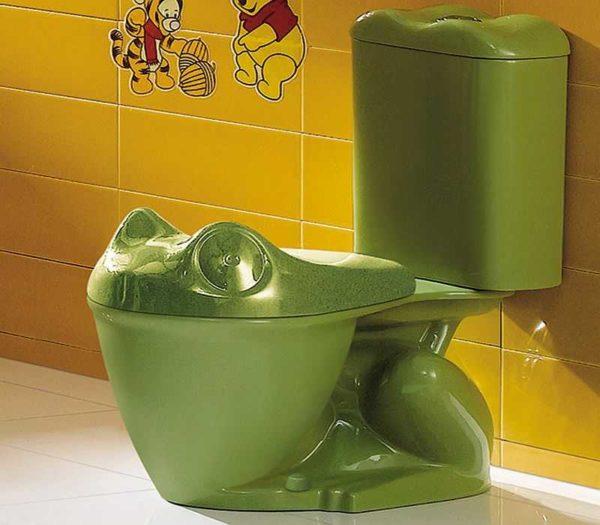
Contents of the article
Internal device
The toilet cistern consists of two simple systems: water intake and its drainage. To eliminate possible malfunctions, it is necessary to understand how everything is arranged and works. First, let’s consider what parts consist of a cistern for the toilet bowl of the old sample. Their system is more understandable and visual, and the work of more modern devices will be understood by analogy.
The internal armature of this type of cistern is very simple. The water supply system is an inlet valve with a float mechanism. The drainage system – a lever and a pear with a drain valve inside. There is also an overflow tube – through it goes excess water from the cistern, bypassing the drain hole.
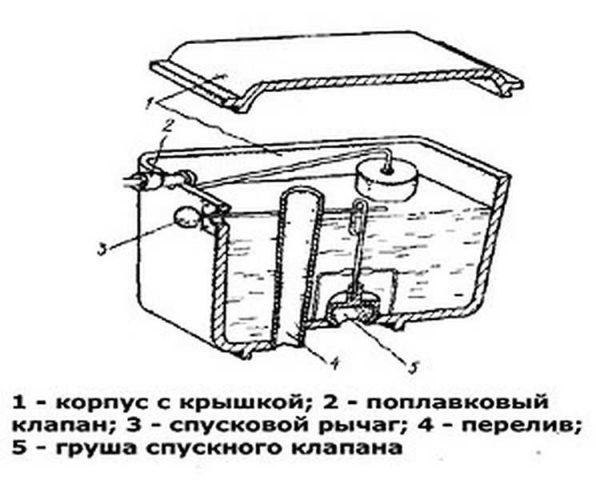
The main thing in this design is the correct operation of the water supply system. A more detailed scheme of its device is shown in the figure below. The inlet valve is connected to the float with the help of a curved lever. This lever presses on the piston, which opens/closes the water supply.
When the tank is full, the float is in the down position. Its lever does not press on the piston and it is pushed back by the water pressure, opening the outlet to the spigot. The water gradually builds up. As the water level rises, the float rises upward. Gradually it pushes up the piston, shutting off the water supply.
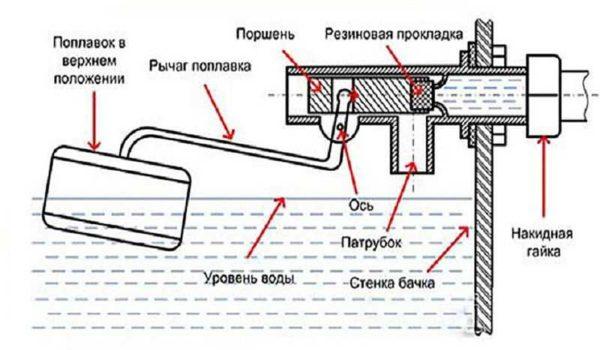
The system is simple and effective, the level of filling the cistern can be changed by bending a little lever. The disadvantage of this system is a noticeable noise when filling.
Now let’s consider how the cistern drain works. In the version shown in the figure above, the drain hole is blocked by a pear of the drain valve. A chain is attached to the pear, which is connected to the drain lever. Press the lever, lift the pear, and the water drains into the hole. When the level drops, the float drops down, opening the water supply. This is how this type of cistern works.
Modern models with a lever drain
Less noisy when filling toilet cisterns with a lower water supply. This is a more modern version of the device described above. Here the faucet/inlet valve is hidden inside the cistern – in the tube (on the photo – gray tube, to which the float is connected).
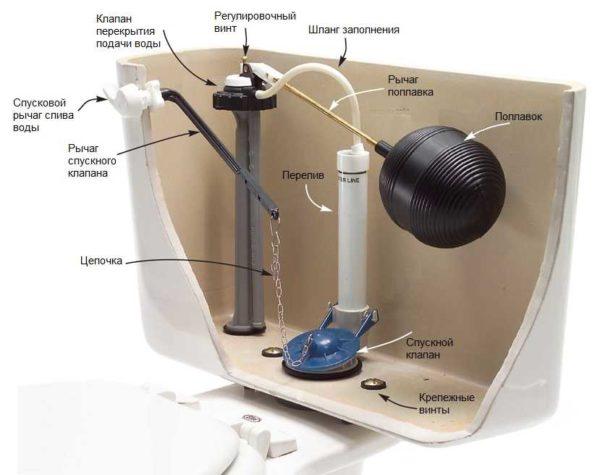
The mechanism of operation is the same – the float is lowered – the valve is open, the water comes in. The cistern is filled, the float rises, the valve closes the water. The drainage system remains in this version almost unchanged. The same valve that rises when the lever is pressed. The water overflow system is almost unchanged as well. It is also a tube, but it is led out into the same drain.
Clearly the work of the cistern of such a system can be seen in the video.
With a button
Models of toilet cisterns with a button have a similar water inlet fitting (there is a side water supply, there is a bottom one). The drain fitting is of a different type.
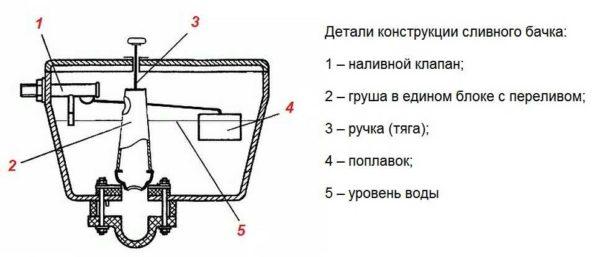
The system presented in the photo is found most often in toilet bowls of domestic production. It is inexpensive and reliable. The device of imported units is different. They mainly have a lower water supply and a different drainage-overflow device (on the photo below).
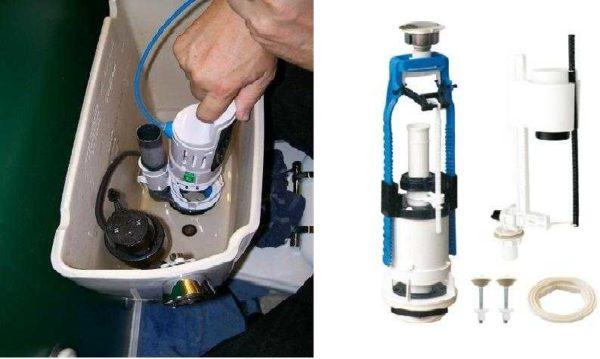
There are different such systems:
- with one button
- water is drained while the button is pressed;
- drainage starts when you press it, stops when you press it again;
- with two buttons, releasing different amounts of water.
The mechanism of operation here is slightly different, although the principle remains the same. In this fitting, when you press the button, the cup rises, blocking the drainage. The rack remains stationary. In short, this is all the difference. The drain is adjusted by means of a swivel nut or a special lever.
Installation and replacement of the cistern fittings
A significant part of the problems with the toilet bowl is solved by adjusting or replacing the cistern fittings. In any case, you need to know how to disassemble and assemble the insides of the cistern. This skill will definitely come in handy. When replacing, first you need to dismantle the old device, and then install a new one. Let’s describe in detail the entire process, including the installation of the new fitting.
How to remove the lid from the cistern
If the cistern with a button is repaired, it is not always immediately clear how to remove the lid. It is not difficult to do this: press the button, turn the ring.
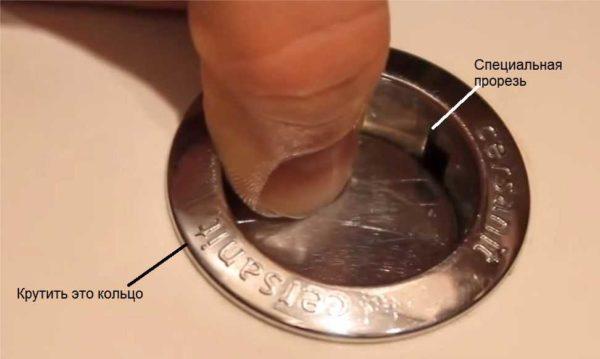
If it does not work with fingers, pressing the button, consider its inner rim. There are two special slots. You can take a screwdriver with a short end, with it turn a little ring. Then you can unscrew it with your fingers.
After that, you remove the button by pulling it upwards. That’s all, the cover can be lifted.
Dismantling the cistern
To replace the old fittings of the cistern, it must be removed from the toilet bowl. First of all, cut off the water supply, then drain the cistern. Then with the help of keys remove the water supply hose (it is attached to the side or bottom).
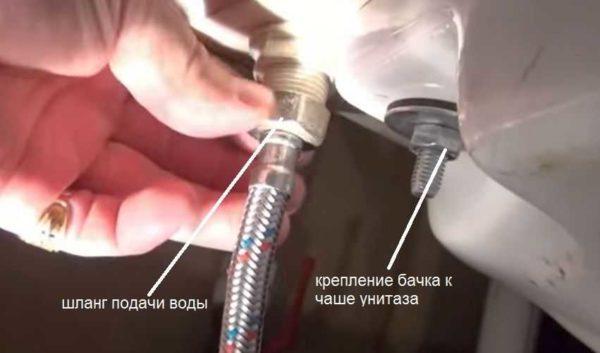
Next, it is necessary to disconnect the cistern from the toilet bowl. If you look under it from below, you can see the bolts that are tightened with nuts. Here they are unscrewed, using a set of horn wrenches or an adjustable wrench. Before this near the toilet bowl put a container or lay a cloth – some amount of water in the cistern always remains, when unscrewing the nuts it will be drained.
Having unscrewed two nuts – on the right and left, remove the cistern. The gasket is usually left on the bowl. If it is deformed or dry, it is also desirable to replace it.
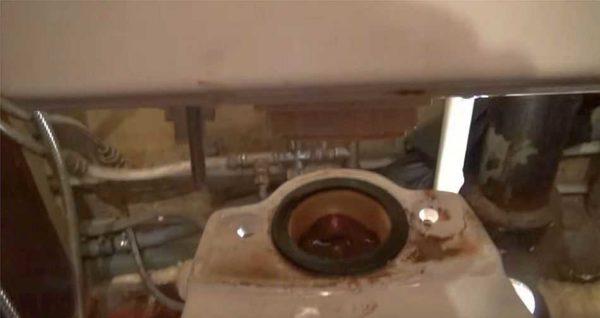
The cistern is placed on a flat surface. In its lower part there is a large plastic nut. It holds the drain mechanism, it is unscrewed. Sometimes the first turns have to be done with an adjustable wrench, but do not squeeze it too much – the plastic can be fragile.
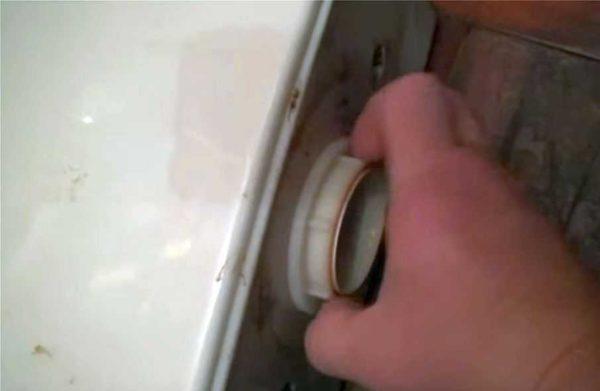
Now the drain mechanism is easily removed.
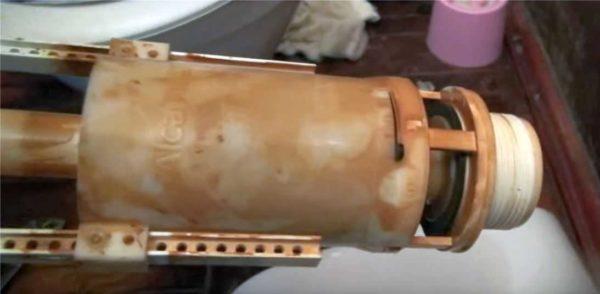
In the same way, we remove the water supply mechanism. With the lower feed, the fastening nut is also located at the bottom (right or left of center).
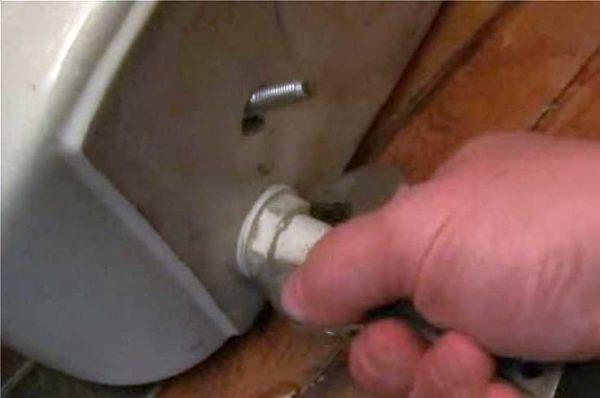
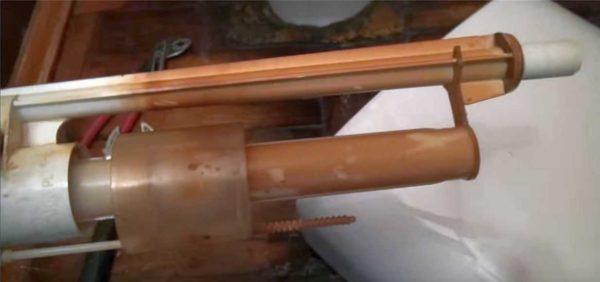
After that, we look inside the cistern. Usually at the bottom there is an accumulation of rusty sediment, small metal particles, sand, etc. All this should be removed, if possible, flushed. The inside should be clean – debris caught under the gaskets can cause leaks. After that we start installation of new fittings.
Mounting the fittings of the cistern
Everything happens in the reverse order. First, we install a new rack of the drain mechanism. Unscrew the plastic nut from it, put a rubber gasket on the spigot. It can be white (as in the photo) or black.
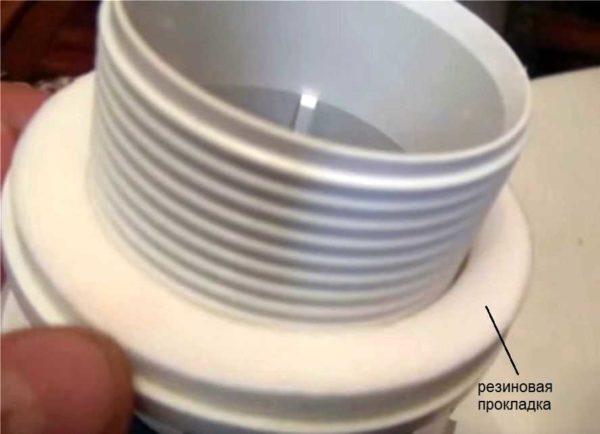
Put the device inside the container and screw on the plastic nut from the outside. Tighten it as far as possible with your fingers, then tighten it a little with a wrench. Do not overtighten – it will burst.
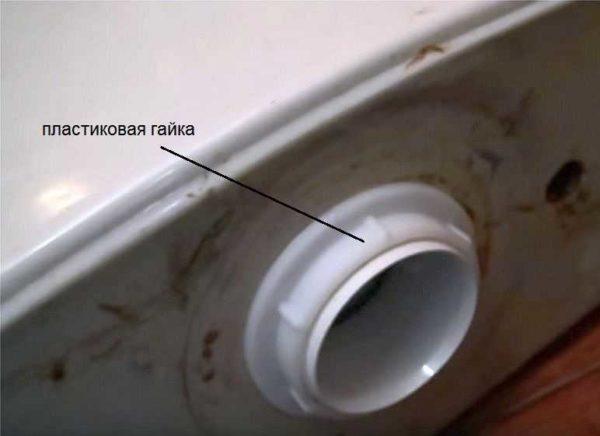
Sealing
Now on the toilet bowl replace the sealing ring, sealing its connection with the cistern. Dirt and rust often accumulate in this place – it should be wiped off beforehand, the seating place should be dry and clean.
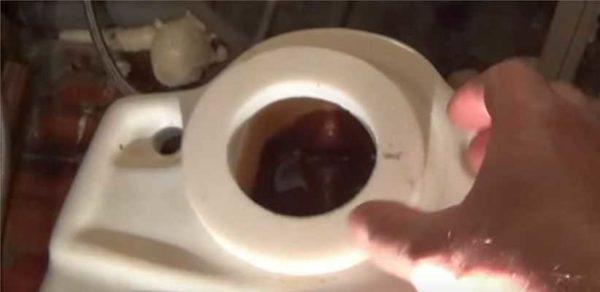
Inside the cistern install the fixing bolts, not forgetting to put the gaskets. The cistern is put in place, as long as it is possible not to level it. The main thing is to hit the screws and the outlet part on the landing places. Take a washer, nut and screw them on the screws.
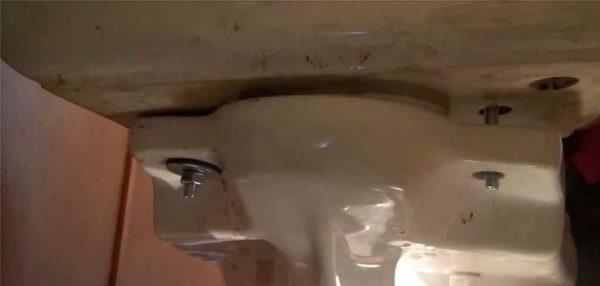
When both nuts are installed, but not yet tightened, level the vessel. Then use a wrench to start tightening the fastener. Turn it a few turns from right to left.
Installing the exhaust valve
In the last turn, we install the inlet valve for the cistern. It could be put earlier, but then it is inconvenient to install the mounting bolts – too little space. On the outlet pipe also put a gasket, then install it inside, fix it with a nut.
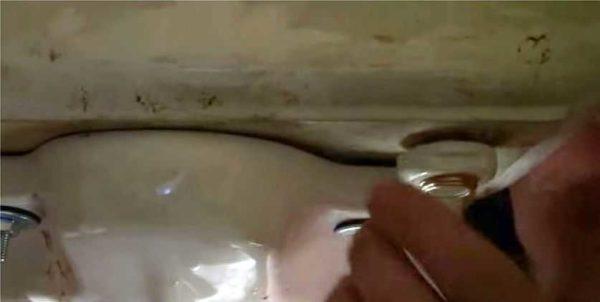
The next step is to connect water to the same spigot. Before connecting the flexible hose for water, open the water for a while, giving the opportunity to remove scale, which accumulates every time after closing the faucet, even for a short time. After draining some water (put a bucket underneath so as not to wet the floor), connect the hose to the connector (turn off the water again).
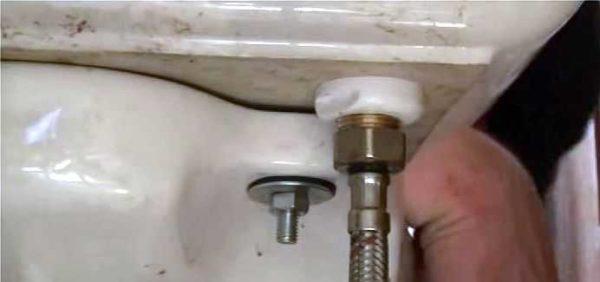
Although the connector is metal, you do not need to tighten this connection too much – first with your fingers, then one turn with a wrench. If you find drops when turning on the water, you can tighten it another half a turn. After that we check whether the system works correctly. If everything is correct, install the cover, screw on the button. You can test it again. This is the end of the installation of the cistern fittings. As you can see, everything can be done with your own hands.
Adjustment and repair
When operating the toilet bowl, problems arise periodically – then it leaks, then, on the contrary, water is not drawn into it. Sometimes, tired of inconvenience, people buy new toilets. And for nothing. Most of the faults are eliminated in 10-20 minutes. Moreover, everything is so simple that everyone can cope. You do not have to call a plumber. You can do everything with your own hands.
Adjusting the water level
We will talk about devices with a lower water supply. After installation, the toilet cistern should be adjusted. By default, from the factory they come exposed to the maximum amount of water in the tank. This amount is often excessive. With a simple adjustment can reduce the volume of water in the cistern. To do this:
The same procedure is necessary if water is constantly dripping from the cistern. One of the reasons is that the float is too high. This causes the water to drain through the overflow system.
With a side water supply and a float mechanism, the adjustment is even easier – we change the position of the float by bending its lever. On the one hand it is easier, but on the other hand it is more complicated. You have to bend it many times to achieve the required level.
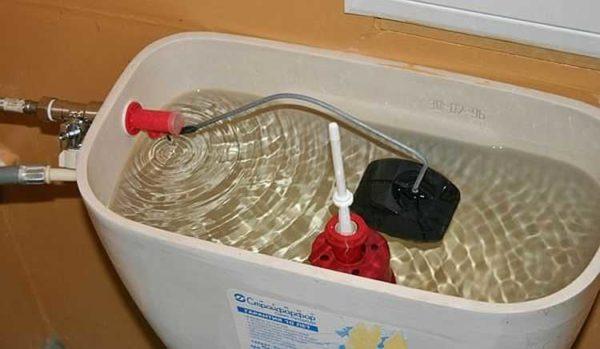
Leaky toilet cistern
If the water in the toilet bowl constantly leaks, but its level is normal, we move on. There are several reasons for the appearance of this leak. And since so, then the ways of elimination will be different.
- The sealing rubber under the drain valve in the cistern is silted up, dirt got under it, a groove (or several) appeared on its surface. The method of treatment – cleaning the current gasket or replacing it with a new one. To resuscitate the old one you need to:
- turn off the water, drain it,
- remove the release mechanism by unscrewing the plastic nut at the bottom;
- pull out the drain valve, remove and examine the gasket, clean it from settled particles, if necessary (there are grooves) grind very fine sandpaper to smoothness;
- put it back in place, connect everything and check the operation.
- The trigger mechanism itself has worn off. To check whether this is the case, you can, with the cover removed, press lightly on the mechanism. If the leakage stops, then this is the problem. If it is still leaking, you should try to clean the gasket (described above) or replace it. If the leakage has stopped when pressing, you can replace the fitting or weight the glass.
Where to put the weighting rod .
To do this, we remove the release mechanism and put something heavy in the lower part of it. This can be several pieces of metal, a sock in which pennies were poured, sand, etc. Put the device in place and check the operation.
Water does not come on
Another problem that can be eliminated with your own hands – does not draw water into the drain cistern. Most likely the matter is in the clog – clogged filter or pipes. To tell a long story, it is better to watch the video.

